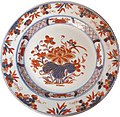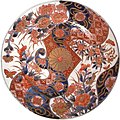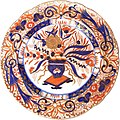Imari porcelain
Imari porcelain ( Japanese 伊万 里 焼 , Imari-yaki , common: 有 田 焼 , Arita-yaki ) denotes Japanese porcelain from the Arita area , which is assigned to the hard-paste porcelain group according to the classification of ceramic bodies .
Naming
The name of this porcelain goes back to the small port of Imari near Arita , from where the goods were brought to Nagasaki to the branch of the Dutch East India Company . Arita and Imari are located in the area of today's Saga Prefecture in the north of the island of Kyushu .
Coloring
Three colors dominate the painting of traditional Imari porcelain, called "Old Imari" (ko-Imari) in Japan : cobalt blue , rust red with a hint of saffron and the white background. The whole thing is emphasized by the use of gold. The painting mainly shows floral patterns, as well as motifs from the animal world and minerals. The brocade effect found many fans at European courts. The Japanese porcelain painters showed a lot of imagination and freedom in designing the motifs. They knew how to divide the area in an original way and also dared asymmetrical compositions.
Historical development
Porcelain production began in Japan in 1616 in this area on the island of Kyushu . According to tradition, it was a Korean named Ri Sampei (Korean I Sam-pyeong ) who, along with thousands of other Korean artists, was abducted to Japan during the Imjin War to exploit a nearby kaolin store at the foot of the Izumiyama Hill. Thanks to his mastery in handling high-temperature ovens, he was able to melt kaolin at a temperature of 1400 ° C and thus produce hard-paste porcelain , similar to Chinese porcelain . This marked the end of a monopoly that had existed for more than seven centuries.
It was a Dresden man , Zacharias Wagner , who discovered this porcelain for Europe. As the chief merchant of the Dutch East India Company ( Verenigde Oostindische Compagnie ), Wagner took over the management of the Dejima branch in Nagasaki for one year in 1656 . Chinese porcelain exports from Jingdezhen ( Chinese 景 徳 鎮 , Japanese Keitokuchin ) had almost come to a standstill as a result of the ongoing fighting between supporters of the Ming Dynasty , which collapsed in 1644, and the troops of the new Qing Dynasty . That is why the company looked for alternative sources of supply from the Middle East to the Far East. Wagner, who had noticed the high quality of the porcelain fired in Arita, had a few samples made, which were examined in Batavia . During his second rotation in Japan, he placed the first large order in 1659. Further orders followed and stimulated a rapid expansion of production capacities as well as an increase in quality. Even after the resurgence of Chinese production, Japanese Imari goods were shipped to Europe in large quantities until 1757.
The Dutch and their clients had a strong influence on the motifs. Little by little, a style developed that primarily served the expectations of aristocratic customers who valued pomp.
In the middle of the 17th century, two other styles developed simultaneously in Arita: the Kakiemon and the Iro-Nabeshima style. The latter owes its name to the princely house of Nabeshima , on whose territory the kaolin deposits and the porcelain factories were located. The Iro-Nabeshima porcelains were originally only fired for the use of the ruling house. The Kakiemon style developed by Sakaida Kakiemon at the beginning of the 17th century is cultivated by his descendants to this day. It is characterized by an exceptionally fine color palette (persimmon orange, yellow, blue, turquoise, etc.) and an ornamentation applied to a white background.
Because of their high quality and price, Imari porcelains have been widely copied. Initially by the Chinese after they got their production going again at the end of the 17th century. In this case one also speaks of the "Chinese Imari".
The first attempts at ceramics took place in Europe, as in Delft (Delft Gold). After Johann Friedrich Böttger discovered the manufacturing technique for porcelain , Japanese motifs then appeared on the products of the Meissen Manufactory . This was followed by the manufacture in Vienna , French factories in Bayeux , Isigny and, at the beginning of the 19th century, Paris . In the 20th century, even Limoges could not avoid the charm of Imari porcelain.
But it was above all the English who received and developed Imari motifs intensively towards the end of the 18th century, especially in the factories in Staffordshire . In the following century, a wealth of motifs arose in the style of a tradition, which developed in close exchange into a common treasure trove of forms from East and West.
literature
- Peter Pantzer : Imari porcelain at the court of Empress Maria Theresa . Hetjens Museum -Deutsches Keramikmuseum, Düsseldorf 2000, ISBN 3-9804529-2-1 .
- Georges Le Gars: Imari, Histoire d'un style, faïences et porcelaines du Japon, de Chine et d'Europe . Massin, Paris 2004, ISBN 2-7072-0482-X .
- Georges Le Gars: Les Imari anglais . Massin, Paris 2007, ISBN 2-7072-0541-9 .
Web links
- Imariyaki. Japanese Architecture and Art Net Users System, accessed March 28, 2013 .



